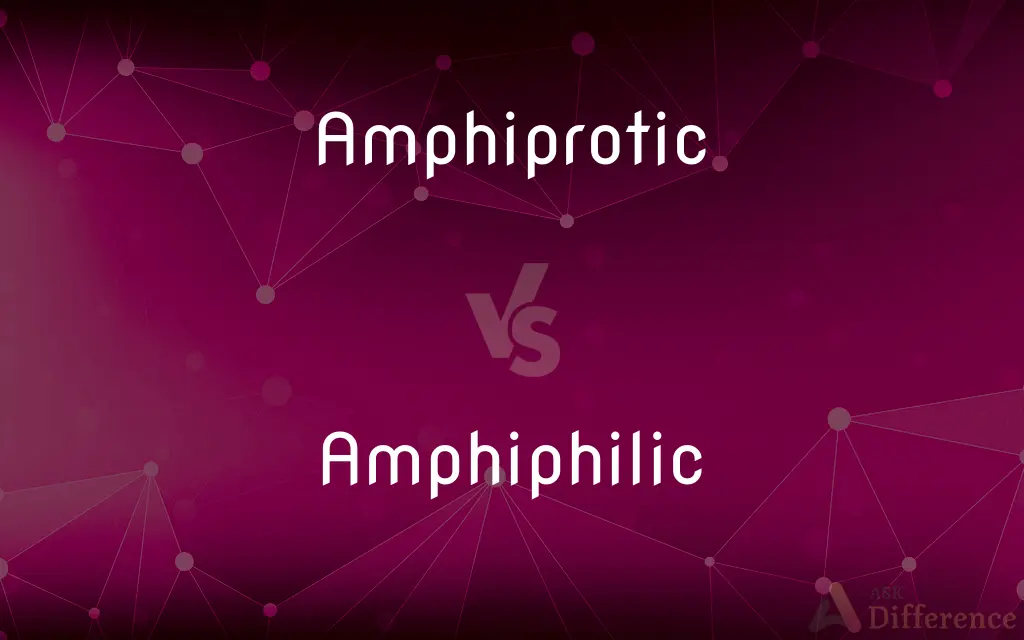Amphiprotic vs. Amphiphilic — What's the Difference?
By Urooj Arif & Fiza Rafique — Updated on April 22, 2024
Amphiprotic substances can donate and accept protons, essential in acid-base reactions, whereas amphiphilic substances contain both hydrophilic and hydrophobic parts, crucial in forming cell membranes.

Difference Between Amphiprotic and Amphiphilic
Table of Contents
ADVERTISEMENT
Key Differences
Amphiprotic substances have the unique ability to act as both acids and bases by donating or accepting protons, depending on the environment. On the other hand, amphiphilic substances are characterized by their dual nature, having both water-attracting (hydrophilic) and water-repelling (hydrophobic) properties, making them essential in biological and chemical systems.
In chemistry, amphiprotic molecules like water or amino acids play a pivotal role in maintaining pH balance and participating in buffer solutions. Amphiphilic molecules, such as soaps and detergents, are crucial for their ability to form micelles and bilayers, which help in the emulsification of fats and oils in aqueous solutions.
The amphiprotic nature of a substance like glycine allows it to stabilize biological and chemical systems by moderating excessive acidity or alkalinity. Amphiphilic compounds, by contrast, are integral to the structure and function of cell membranes, enabling the compartmentalization of cellular processes.
In biological systems, amphiprotic substances participate in enzyme reactions and energy transformations, showcasing their versatility. Conversely, amphiphilic substances form the basis of lipid bilayers in cell membranes, crucial for cellular integrity and communication.
Amphiprotic compounds often require specific environmental conditions to exhibit both their acidic and basic characteristics effectively. Amphiphilic compounds, however, demonstrate their dual affinity in a wide range of environments, impacting everything from drug delivery systems to environmental cleanup technologies.
ADVERTISEMENT
Comparison Chart
Definition
Can donate and accept protons.
Contains both hydrophilic and hydrophobic parts.
Common Examples
Water, amino acids, hydrogen carbonate.
Soaps, detergents, phospholipids.
Role in Biological Systems
Buffer solutions, enzyme activity.
Cell membrane structure, micelle formation.
Chemical Behavior
Acts as both acid and base.
Forms structures like micelles and bilayers.
Importance in Industry
Pharmaceuticals, chemical synthesis.
Cosmetics, pharmaceuticals, food industry.
Compare with Definitions
Amphiprotic
Participates in buffer systems.
The bicarbonate system in blood is amphiprotic, helping maintain pH balance.
Amphiphilic
Used in drug delivery systems.
Amphiphilic polymers can encapsulate drugs, improving their delivery in the body.
Amphiprotic
Essential in dynamic equilibrium in solutions.
Amphiprotic substances are critical in water's self-ionization.
Amphiphilic
Has both hydrophilic and hydrophobic parts.
Detergents are amphiphilic, making them effective in cleaning oily substances.
Amphiprotic
Exhibits dual acid-base nature.
Amino acids are amphiprotic, functioning as acids and bases in peptide formations.
Amphiphilic
Vital in micelle and bilayer formation.
Phospholipids are amphiphilic, crucial for forming cellular membranes.
Amphiprotic
Involves reversible proton transfer.
Hydrogen sulfate ion is amphiprotic, capable of gaining or losing a proton.
Amphiphilic
Important in industrial applications.
Amphiphilic coatings are used to create water-repellent surfaces.
Amphiprotic
Able to donate or accept protons.
Water acts as an amphiprotic substance when it both donates a proton to form OH⁻ and accepts a proton to form H₃O⁺.
Amphiphilic
Enhances solubility of compounds in water.
Amphiphilic molecules aid in the solubilization of vitamins in dietary supplements.
Amphiprotic
(chemistry) Able to both donate and accept a proton, and thus able to react both as an acid and a base; amphoteric.
Amphiphilic
Of or relating to a molecule having a polar, water-soluble group attached to a nonpolar, water-insoluble hydrocarbon chain.
Amphiprotic
Having characteristics of both an acid and a base and capable of reacting as either
Amphiphilic
Being a detergent: having both hydrophilic and hydrophobic (or lipophilic) groups.
Amphiphilic
Having one surface consisting of hydrophilic amino acids and the opposite surface consisting of hydrophobic (or lipophilic) ones.
Common Curiosities
What types of industries rely on the use of amphiphilic substances?
Industries such as cosmetics, pharmaceuticals, food processing, and environmental management heavily rely on amphiphilic substances.
Can amphiprotic substances change their behavior based on their environment?
Yes, the behavior of amphiprotic substances can change depending on the surrounding pH level, allowing them to act as either an acid or a base.
What is the significance of amphiphilic substances in medicine?
Amphiphilic substances are crucial in medicine for creating drug delivery systems that improve the solubility and efficacy of hydrophobic drugs.
What is a common example of an amphiprotic molecule in the human body?
Amino acids are common amphiprotic molecules that contribute to protein structure and function in the human body.
How does the amphiphilic nature of a substance affect its solubility in water?
The hydrophilic part of an amphiphilic molecule can interact with water, making it soluble, while the hydrophobic part tends to repel water.
How do amphiprotic substances contribute to acid-base homeostasis in the human body?
They are part of buffering systems that regulate and stabilize the pH of body fluids, including blood.
What role do amphiprotic substances play in environmental science?
Amphiprotic substances are used in environmental buffering systems to control pH levels in soils and aquatic environments.
How do amphiprotic and amphiphilic substances interact in biological membranes?
Amphiprotic substances can stabilize biological membranes through ionic interactions, while amphiphilic substances make up the structural framework of membranes.
Why are amphiprotic buffers important in biochemical reactions?
They help maintain a stable pH, which is crucial for the optimal activity and stability of enzymes in biochemical reactions.
How do amphiphilic substances aid in cleaning processes?
They help in cleaning by forming micelles that encapsulate dirt and oil, making them easier to wash away with water.
What is an example of an amphiprotic compound used in industrial processes?
Sodium bicarbonate, used in food processing and cleaning applications, is an example of an industrial amphiprotic compound.
How do amphiprotic substances differ from typical acids or bases?
Amphiprotic substances can act as both an acid and a base, unlike typical acids which only donate protons, or bases which only accept protons.
Are all amphiprotic substances also amphoteric?
Yes, all amphiprotic substances are amphoteric, meaning they can react with both acids and bases.
What is the difference in molecular structure between amphiprotic and amphiphilic substances?
Amphiprotic substances typically have reversible proton sites, while amphiphilic substances consist of distinct hydrophilic and hydrophobic regions.
Can amphiphilic substances form structures other than micelles and bilayers?
Yes, amphiphilic substances can also form vesicles and other complex structures, depending on their concentration and the environmental conditions.
Share Your Discovery

Previous Comparison
King vs. Regent
Next Comparison
Breathing vs. VentilationAuthor Spotlight
Written by
Urooj ArifUrooj is a skilled content writer at Ask Difference, known for her exceptional ability to simplify complex topics into engaging and informative content. With a passion for research and a flair for clear, concise writing, she consistently delivers articles that resonate with our diverse audience.
Co-written by
Fiza RafiqueFiza Rafique is a skilled content writer at AskDifference.com, where she meticulously refines and enhances written pieces. Drawing from her vast editorial expertise, Fiza ensures clarity, accuracy, and precision in every article. Passionate about language, she continually seeks to elevate the quality of content for readers worldwide.














































